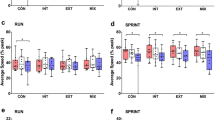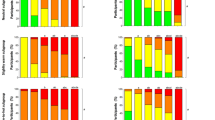Abstract
The aim of this two-part experiment was to investigate the effect of cooling the neck on time-trial performance in hot conditions (~30°C; 50% RH). In Study A, nine participants completed a 75-min submaximal (~60% \( \dot{V}{\text{O}}_{{ 2 {\text{max}}}} \)) pre-load phase followed by a 15-min self-paced time-trial (TT) on three occasions: one with a cooling collar (CC90), one without a collar (NC90) and one with the collar uncooled (C90). In Study B, eight participants completed a 15-min TT twice: once with (CC15) and once without (NC15) a cooling collar. Time-trial performance was significantly improved in Study A in CC90 (3,030 ± 485 m) compared to C90 (2,741 ± 537 m; P = 0.008) and NC90 (2,884 ± 571 m; P = 0.041). Fifteen-minute TT performance was unaffected by the collar in Study B (CC15 = 3,239 ± 267 m; NC15 = 3,180 ± 271 m; P = 0.351). The collar had no effect on rectal temperature, heart rate or RPE. There was no effect of cooling the neck on S100β, cortisol, prolactin, adrenaline, noradrenaline or dopamine concentrations in Study A. Cooling the neck via a cooling collar can improve exercise performance in a hot environment but it appears that there may be a thermal strain threshold which must be breached to gain a performance benefit from the collar.






Similar content being viewed by others
References
Anderson RE, Hansson LO, Nilsson O, jlai-Merzoug R, Settergren G (2001) High serum S100B levels for trauma patients without head injuries. Neurosurgery 48(6):1255–1258
Ansley L, Marvin G, Sharma A, Kendall MJ, Jones DA, Bridge MW (2009) The effects of head cooling on endurance and neuroendocrine responses to exercise in warm conditions. Physiol Res 57(6):863–872
Arngrimsson SA, Petitt DS, Stueck MG, Jorgensen DK, Cureton KJ (2004) Cooling vest worn during active warm-up improves 5-km run performance in the heat. J Appl Physiol 96(5):1867–1874
Baker MA (1982) Brain cooling in endotherms in heat and exercise. Annu Rev Physiol 44:85–96
Borg GA (1982) Psychophysical bases of perceived exertion. Med Sci Sports Exerc 14(5):377–381
Brengelmann GL (1993) Specialized brain cooling in humans? FASEB J 7(12):1148–1152
Brisson GR, Bouchard J, Peronnet F, Boisvert P, Garceau F (1987) Evidence for an interference of selective face ventilation on hyperprolactinemia induced by hyperthermic treadmill running. Int J Sports Med 8(6):387–391
Bulbulian R, Shapiro R, Murphy M, Levenhagen D (1999) Effectiveness of a commercial head-neck cooling device. J Strength Cond Res 13(3):198–205
Caputa M, Feistkorn G, Jessen C (1986) Effects of brain and trunk temperatures on exercise performance in goats. Pflugers Arch 406(2):184–189
Cohen J (1988) Statistical power analysis for the behavioral sciences, 2nd edn. Lawrence Erlbaum, New Jersey
Dill DB, Costill DL (1974) Calculation of percentage changes in volumes of blood, plasma, and red cells in dehydration. J Appl Physiol 37(2):247–248
Fernstrom JD, Fernstrom MH (2006) Exercise, serum free tryptophan, and central fatigue. J Nutr 136(2):553S–559S
Galloway SDR, Maughan RJ (1997) Effects of ambient temperature on the capacity to perform prolonged exercise in man. Med Sci Sports Exerc 29:1240–1249
Gonzalez-Alonso J, Teller C, Andersen SL, Jensen FB, Hyldig T, Nielsen B (1999) Influence of body temperature on the development of fatigue during prolonged exercise in the heat. J Appl Physiol 86(3):1032–1039
Gordon NF, Bogdanffy GM, Wilkinson J (1990) Effect of a practical neck cooling device on core temperature during exercise. Med Sci Sports Exerc 22(2):245–249
Guatteo E, Chung KK, Bowala TK, Bernardi G, Mercuri NB, Lipski J (2005) Temperature sensitivity of dopaminergic neurons of the substantia nigra pars compacta: involvement of transient receptor potential channels. J Neurophysiol 94(5):3069–3080
Hamada S, Torii M, Szygula Z, Adachi K (2006) Effect of partial body cooling on thermophysiological responses during cycling work in a hot environment. J Therm Biol 31:194–207
Hessemer V, Langusch D, Bruck LK, Bodeker RH, Breidenbach T (1984) Effect of slightly lowered body temperatures on endurance performance in humans. J Appl Physiol 57(6):1731–1737
Jones AM, Doust J (1996) A comparison of three protocols for the determination of maximal aerobic power in runners. J Sports Sci 14:S89
Kotchen TA, Hartley LH, Rice TW, Mougey EH, Jones LG, Mason JW (1971) Renin, norepinephrine, and epinephrine responses to graded exercise. J Appl Physiol 31(2):178–184
Lee DT, Haymes EM (1995) Exercise duration and thermoregulatory responses after whole body precooling. J Appl Physiol 79(6):1971–1976
Meeusen R, Watson P, Hasegawa H, Roelands B, Piacentini MF (2006) Central fatigue: the serotonin hypothesis and beyond. Sports Med 36(10):881–909
Mueller FO, Cantu RC (2007) National Center for Catastrophic Sport Injury Research data tables: annual survey of football injury research 1931–2007. Accessed 29 March 2010. http://www.unc.edu/depts/nccsi/FootballInjuryData.htm
Mundel T, Hooper PL, Bunn SJ, Jones DA (2006) The effects of face cooling on the prolactin response and subjective comfort during moderate passive heating in humans. Exp Physiol 91(6):1007–1014
Nielsen B, Hales JR, Strange S, Christensen NJ, Warberg J, Saltin B (1993) Human circulatory and thermoregulatory adaptations with heat acclimation and exercise in a hot, dry environment. J Physiol 460:467–485
Nunneley SA, Troutman SJ Jr, Webb P (1971) Head cooling in work and heat stress. Aerospace Med 42(1):64–68
Nybo L, Secher NH, Nielsen B (2002) Inadequate heat release from the human brain during prolonged exercise with hyperthermia. J Physiol 545(Pt 2):697–704
Palmer CD, Sleivert G, Cotter JD (2001) The effects of head and neck cooling on thermoregulation, pace selection and performance. Proc Aust Physiol Pharmacol Soc 32(2):122P
Ramanathan NL (1964) A new weighting system for mean surface temperature of the human body. J Appl Physiol 19:531–533
Roelands B, Hasegawa H, Watson P, Piacentini MF, Buyse L, De SG, Meeusen RR (2008) The effects of acute dopamine reuptake inhibition on performance. Med Sci Sports Exerc 40(5):879–885
Sharma HS, Cervos-Navarro J, Dey PK (1991) Increased blood-brain barrier permeability following acute short-term swimming exercise in conscious normotensive young rats. Neurosci Res 10(3):211–221
Shiraki K, Sagawa S, Tajima F, Yokota A, Hashimoto M, Brengelmann GL (1988) Independence of brain and tympanic temperatures in an unanesthetized human. J Appl Physiol 65(1):482–486
Shvartz E (1970) Effect of a cooling hood on physiological responses to work in a hot environment. J Appl Physiol 29(1):36–39
Shvartz E (1976) Effect of neck versus chest cooling on responses to work in heat. J Appl Physiol 40(5):668–672
Simmons SE, Mundel T, Jones DA (2008) The effects of passive heating and head-cooling on perception of exercise in the heat. Eur J Appl Physiol 104:271–280
Sukstanskii AL, Yablonskiy DA (2004) An analytical model of temperature regulation in human head. J Therm Biol 29(7–8):583–587
Tucker R, Rauch L, Harley YX, Noakes TD (2004) Impaired exercise performance in the heat is associated with an anticipatory reduction in skeletal muscle recruitment. Pflugers Arch 448(4):422–430
Tyler C, Sunderland C (2008) The effect of ambient temperature on the reliability of a preloaded treadmill time-trial. Int J Sports Med 29:812–816
Watson P, Shirreffs SM, Maughan RJ (2005) Blood-brain barrier integrity may be threatened by exercise in a warm environment. Am J Physiol Regul Integr Comp Physiol 288(6):R1689–R1694
Yeargin SW, Casa DJ, McClung JM, Knight JC, Healey JC, Goss PJ, Harvard WR, Hipp GR (2006) Body cooling between two bouts of exercise in the heat enhances subsequent performance. J Strength Cond Res 20(2):383–389
Young AJ, Sawka MN, Epstein Y, Decristofano B, Pandolf KB (1987) Cooling different body surfaces during upper and lower body exercise. J Appl Physiol 63(3):1218–1223
Zhu L (2000) Theoretical evaluation of contributions of heat conduction and countercurrent heat exchange in selective brain cooling in humans. Ann Biomed Eng 28(3):269–277
Acknowledgments
The authors would like to thank Dr Philip Hennis, Dr Hannah MacLeod and Mr Ian Varley for their assistance with data collection. The authors would also like to thank Dr Craig Sale and Dr John Morris for taking the time to read through the manuscript. The studies conducted in this manuscript were conducted while all authors were at Nottingham Trent University, UK.
Conflict of interest
The authors have no relationships or affiliations with any companies or manufacturers to disclose. The results presented in this manuscript do not constitute endorsement by the authors or the European Journal of Applied Physiology.
Author information
Authors and Affiliations
Corresponding author
Additional information
Communicated by George Havenith.
Rights and permissions
About this article
Cite this article
Tyler, C.J., Wild, P. & Sunderland, C. Practical neck cooling and time-trial running performance in a hot environment. Eur J Appl Physiol 110, 1063–1074 (2010). https://doi.org/10.1007/s00421-010-1567-7
Accepted:
Published:
Issue Date:
DOI: https://doi.org/10.1007/s00421-010-1567-7




